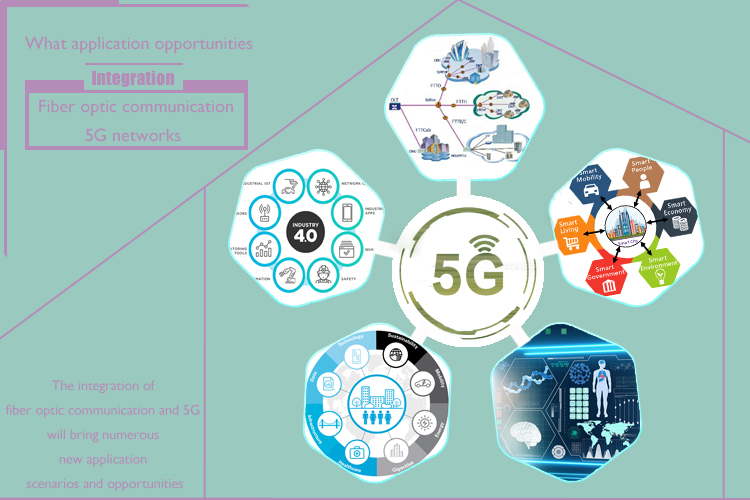Application Opportunities Arising from the Integration of
Fiber Optic Communication and 5G Networks
In today's interconnected world, the integration of fiber optic communication and 5G networks holds immense promise for various sectors. This technological convergence paves the way for exciting application opportunities that can revolutionize industries and enhance the quality of life. In this article, we will explore four key areas where the integration of fiber optic communication and 5G networks will bring about significant advancements. These areas include mobile edge computing, vehicle-to-everything (V2X) communication, the industrial internet, and smart cities.

1. Mobile Edge Computing
Mobile edge computing (MEC) refers to the decentralization of computing and storage resources to the network's edge, reducing latency and improving the performance of emerging applications such as the Internet of Things (IoT) and augmented reality/virtual reality (AR/VR). By integrating fiber optic communication and 5G networks, MEC can leverage the high bandwidth and low latency capabilities of fiber optics to bring computing power closer to the end-users. This proximity allows for real-time data processing, enabling rapid decision-making and enhancing user experiences.
2. Vehicle-to-Everything (V2X) Communication
With the rise of autonomous vehicles and smart transportation systems, reliable and low-latency communication between vehicles and their surroundings is crucial. The integration of fiber optic communication and 5G networks enables V2X communication, providing temporary, high-reliability, and low-latency fiber optic connections. This integration ensures seamless vehicle-to-vehicle interaction, enabling safer and more efficient transportation. From advanced driver-assistance systems to cooperative collision avoidance, V2X communication opens up a world of possibilities for the automotive industry.
3. Industrial Internet
The industrial internet, also known as Industry 4.0, is transforming traditional manufacturing processes into intelligent manufacturing systems. By integrating fiber optic communication and 5G networks, industries can establish a solid information exchange foundation. This integration allows for real-time monitoring, data analytics, and seamless communication between machines and systems. Industrial 5G networks built upon fiber optic infrastructure enable ultra-reliable and low-latency communication, facilitating remote control, predictive maintenance, and efficient resource allocation. These advancements result in increased productivity, reduced downtime, and improved overall operational efficiency.
4. Smart Cities
Smart cities aim to enhance the quality of life for residents by leveraging advanced technologies. The integration of fiber optic communication and 5G networks plays a crucial role in constructing a comprehensive perception-based infrastructure network. Fiber optics enable high-speed and reliable connectivity, while 5G networks provide the necessary bandwidth and low latency for numerous smart city applications. From smart traffic management systems to intelligent energy grids and environmental monitoring, the integration of these technologies enables seamless data transmission and efficient resource management. This integration ensures that essential public services are optimized, leading to improved safety, reduced energy consumption, and enhanced resident experiences.
In conclusion, the integration of fiber optic communication and 5G networks presents a multitude of application opportunities across various sectors. From mobile edge computing and V2X communication to the industrial internet and smart cities, this convergence enables transformative advancements. As we move forward, the seamless integration of fiber optics and 5G will continue to shape and redefine industries, offering unparalleled benefits and possibilities.
FAQs
1. How does mobile edge computing benefit from the integration of fiber optic communication and 5G networks?
Mobile edge computing leverages the high bandwidth and low latency capabilities of fiber optics, combined with the speed and reliability of 5G networks, to bring computing power closer to end-users. This proximity allows for real-time data processing, reducing latency for emerging applications such as IoT and AR/VR.
2. What advantages does V2X communication offer in the transportation sector?
V2X communication, made possible by integrating fiber optic communication and 5G networks, ensures seamless vehicle-to-vehicle interaction, enabling safer and more efficient transportation. It facilitates advanced driver-assistance systems, cooperative collision avoidance, and improved traffic management.
3. How does the industrial internet benefit from the integration of fiber optics and 5G networks?
Integrating fiber optics and 5G networks in the industrial internet allows for real-time monitoring, data analytics, and seamless communication between machines and systems. This integration enables ultra-reliable and low-latency communication, resulting in increased productivity, reduced downtime, and improved operational efficiency.
4. What role do fiber optic communication and 5G networks play in the development of smart cities?
Fiber optic communication provides high-speed and reliable connectivity, while 5G networks offer the necessary bandwidth and low latency for smart city applications. This integration enables seamless data transmission and efficient resource management, leading to improved safety, reduced energy consumption, and enhanced resident experiences.
5. How will the integration of fiber optic communication and 5G networks impact future technological advancements?
The integration of fiber optic communication and 5G networks sets the stage for transformative advancements in multiple sectors. It enables faster and more reliable communication, real-time data processing, and enhanced connectivity, laying the foundation for future innovations and technological breakthroughs.
Keywords: fiber optic communication, 5G networks, mobile edge computing, V2X communication, industrial internet, smart cities.

 The Future of Fiber Optic Communication Network Architecture: Evolution and the Role of SDON Technology
The Future of Fiber Optic Communication Network Architecture: Evolution and the Role of SDON Technology
 What opportunities and challenges does free-space optical communication technology face?
What opportunities and challenges does free-space optical communication technology face?
 Opelink MPO Products for High-Speed Data Center Applications
Opelink MPO Products for High-Speed Data Center Applications
 CWDM vs. DWDM: Which Optical Transmission Technology Should You Choose?
CWDM vs. DWDM: Which Optical Transmission Technology Should You Choose?